Broken Ice Photogrammetry in Model-Scale Experiments with Sloped Structure
Abstract
:1. Introduction
2. Experiments
2.1. Experimental Setup
2.2. Ice Model’s Characteristics
2.3. Image Acquisition and Processing
3. The Method
4. Results
4.1. Modeled Ice Beams and Planes: Floe Fragments
4.2. Modeled Ice Plane: Ice Rubble
5. Discussion
- -
- Dynamically moving ice blocks are very often in the plane with unknown angles to the matrix of a camera. Hence, the correct orthorectification and dimension acquisition become impossible.
- -
- In a chaotic pile, it can be very difficult to locate the edges of the blocks. Even manual tracing with a thorough investigation of a zoomed image can be uncertain. There is a lack of algorithmic solutions for contour tracing that could be applicable to the case of an ice rubble pile. This is mostly due to the background color of the mashed ice.
6. Conclusions
Author Contributions
Funding
Institutional Review Board Statement
Informed Consent Statement
Acknowledgments
Conflicts of Interest
References
- Weissling, B.; Ackley, S.; Wagner, P.; Xie, H. EISCAM—Digital image acquisition and processing for sea ice parameters from ships. Cold Reg. Sci. Technol. 2009, 57, 49–60. [Google Scholar] [CrossRef]
- Lu, P.; Li, Z.J.; Zhang, Z.H.; Dong, X.L. Aerial observations of floe size distribution in the marginal ice zone of summer Prydz Bay. J. Geophys. Res. Oceans 2008, 113, C2. [Google Scholar] [CrossRef]
- Steer, A.; Worby, A.; Heil, P. Observed changes in sea-ice floe size distribution during early summer in the western Weddell Sea. Deep Sea Res. Part II Top. Stud. Oceanogr. 2008, 55, 933–942. [Google Scholar] [CrossRef]
- Toyota, T.; Haas, C.; Tamura, T. Size distribution and shape properties of relatively small sea-ice floes in the Antarctic marginal ice zone in late winter. Deep Sea Res. Part. II Top. Stud. Oceanogr. 2011, 58, 1182–1193. [Google Scholar] [CrossRef] [Green Version]
- Perovich, D.K.; Jones, K.F. The seasonal evolution of sea ice floe size distribution. J. Geophys. Res. Oceans 2014, 119, 8767–8777. [Google Scholar] [CrossRef] [Green Version]
- Shimoda, H.; Endoh, T.; Muramoto, K.; Ono, N.; Takizawa, T.; Ushio, S.; Kawamura, T.; Ohshima, K.I. Observations of sea-ice conditions in the Antarctic coastal region using ship-board video cameras. Antarct. Rec. 1997, 41, 355–365. [Google Scholar]
- Niioka, T.; Cho, K. Sea ice thickness measurement from an ice breaker using a stereo imaging system consisted of a pairs of high definition video cameras. In International Archives of the Photogrammetry, Remote Sensing and Spatial Information Sciences—ISPRS Archives; International Society for Photogrammetry and Remote Sensing: Hannover, Germany, 2010; Volume 38, pp. 1053–1056. [Google Scholar]
- Kulovesi, J.; Lehtiranta, J. Level Ice Thickness Measurement Using Ship-Based Semi-Automatic Computer Vision. In Proceedings of the 22nd IAHR International Symposium on Ice, Singapore, 11–15 August 2014; pp. 679–686. [Google Scholar]
- Zambon, A.; Moro, L.; Brown, J.; Kennedy, A.; Oldford, D. A Measurement System to Monitor Propulsion Performance and Ice-Induced Shaftline Dynamic Response of Icebreakers. J. Mar. Sci. Eng. 2022, 10, 522. [Google Scholar] [CrossRef]
- Toyota, T.; Takatsuji, S.; Nakayama, M. Characteristics of sea ice floe size distribution in the seasonal ice zone. Geophys. Res. Lett. 2006, 33. [Google Scholar] [CrossRef] [Green Version]
- Alberello, A.; Onorato, M.; Bennetts, L.; Vichi, M.; Eayrs, C.; Machutchon, K.; Toffoli, A. Brief communication: Pancake ice floe size distribution during the winter expansion of the Antarctic marginal ice zone. Cryosphere 2019, 13, 41–48. [Google Scholar] [CrossRef] [Green Version]
- Roach, L.A.; Smith, M.M.; Dean, S.M. Quantifying Growth of Pancake Sea Ice Floes Using Images From Drifting Buoys. J. Geophys. Res. Oceans 2018, 123, 2851–2866. [Google Scholar] [CrossRef]
- Zhang, Q.; Skjetne, R. Image processing for identification of sea-ice floes and the floe size distributions. IEEE Trans. Geosci. Remote Sens. 2015, 53, 2913–2924. [Google Scholar] [CrossRef]
- Zhang, Q.; Skjetne, R.; Metrikin, I.; Løset, S. Image processing for ice floe analyses in broken-ice model testing. Cold Reg. Sci. Technol. 2015, 111, 27–38. [Google Scholar] [CrossRef] [Green Version]
- Reimer, N. Model tests on wave induced sea ice breakup. In Proceedings of the Arctic Technology Conference Offshore Technology Conference, Houston, TX, USA, 24–26 October 2016. [Google Scholar] [CrossRef]
- Herman, A.; Evers, K.U.; Reimer, N. Floe-size distributions in laboratory ice broken by waves. Cryosphere 2018, 12, 685–699. [Google Scholar] [CrossRef] [Green Version]
- Gutiérrez-Romero, J.E.; Ruiz-Capel, S.; Esteve-Pérez, J.; Zamora-Parra, B.; Luna-Abad, J.P. Methodology Based on Photogrammetry for Testing Ship-Block Resistance in Traditional Towing Tanks: Observations and Benchmark Data. J. Mar. Sci. Eng. 2022, 10, 246. [Google Scholar] [CrossRef]
- Zvyagin, P.; Voitkunskaia, A.; Maksimov, E. Noise analysis of model ice contours in images. In Proceedings of the 25th POAC Conference, Delft, The Netherlands, 9–13 June 2019. [Google Scholar]
- Kjerstad, O.K.; Metrikin, I.; Løset, S.; Skjetne, R. Experimental and phenomenological investigation of dynamic positioning in managed ice. Cold Reg. Sci. Technol. 2015, 111, 67–79. [Google Scholar] [CrossRef]
- Zong, Z.; Yang, B.Y.; Sun, Z.; Zhang, G.Y. Experimental study of ship resistance in artificial ice floes. Cold Reg. Sci. Technol. 2020, 176, 103102. [Google Scholar] [CrossRef]
- Mintu, S.; Molyneux, D. Experimental study of combined wave and ice loads on a fixed offshore structure. In Proceedings of the 40th OMAE Conference, Virtual, Online, 21–30 June 2021. [Google Scholar] [CrossRef]
- van den Berg, M.; Lubbad, R.; Løset, S. Repeatability of ice-tank tests with broken ice. Mar. Struct. 2020, 74, 102827. [Google Scholar] [CrossRef]
- Frederking, R.M.W.; Timco, G.W. Quantitative analysis of ice sheet failure against an inclined plane. J. Energy Resour. Technol. 1985, 107, 381–387. [Google Scholar] [CrossRef] [Green Version]
- Paavilainen, J.; Tuhkuri, J.; Polojärvi, A. 2D numerical simulations of ice rubble formation process against an inclined structure. Cold Reg. Sci. Technol. 2011, 68, 20–34. [Google Scholar] [CrossRef]
- Liang, L.; Shkhinek, K.N. Dynamic interaction between ice and inclined structure. Mag. Civ. Eng. 2014, 45, 71–79. [Google Scholar] [CrossRef]
- Lemström, I.; Polojärvi, A.; Tuhkuri, J. Model-scale tests on ice-structure interaction in shallow water, Part I: Global ice loads and the ice loading process. Mar. Struct. 2022, 81, 103106. [Google Scholar] [CrossRef]
- Zvyagin, P.; Sazonov, K. Analysis and probabilistic modeling of the unstationary ice loads stochastic process, based on experiments with models of offshore structures. In Proceedings of the 34th OMAE Conference, St. Johns, NL, Canada, 31 May–5 June 2015. [Google Scholar] [CrossRef]
- Repetto-Llamazares, A.H.V.; Gudmestad, O.T.; Gürtner, A.; Høyland, K.V. Shoulder ice barrier ice tank testing part II: Estimation of breaking length and block size using image analysis. In Proceedings of the 28th OMAE Conference, Honolulu, HI, USA, 31 May—6 June 2009; pp. 23–31. [Google Scholar] [CrossRef]
- Serré, N.; Lu, W.; Høyland, K.; Bonnemaire, B.; Borge, J.; Evers, K.U. Rubble ice transport on Arctic Offshore Structures (RITAS), Part II: 2D scale-model study of the level ice action. In Proceedings of the 22nd POAC Conference, Espoo, Finland, 9–13 June 2013. [Google Scholar]
- Timofeev, O.Y.; Sazonov, K.E.; Dobrodeev, A.A. New ice basin of the Krylov State Research Centre. In Proceedings of the 23rd POAC Conference, Trondheim, Norway, 14–18 June 2015. [Google Scholar]
- Wilkman, G.; Leiviskä, T. Forty three years of ice model testing in Finland. In Proceedings of the 22nd POAC conference, Espoo, Finland, 9–13 June 2013. [Google Scholar]
- von Bock und Polach, R.; Ehlers, S.; Kujala, P. Model-scale ice—Part A: Experiments. Cold Reg. Sci. Technol. 2013, 94, 74–81. [Google Scholar] [CrossRef]
- von Bock und Polach, R.U.F.; Ettema, R.; Gralher, S.; Kellner, L.; Stender, M. The non-linear behavior of aqueous model ice in downward flexure. Cold Reg. Sci. Technol. 2019, 165, 102775. [Google Scholar] [CrossRef] [Green Version]
- Evers, K.U. Model tests with ships and offshore structures in HSVA’s ice tanks. In Proceedings of the 24th POAC Conference, Busan, Korea, 11–16 June 2017. [Google Scholar]
- ITTC. Test Methods for Model Ice Properties; Revision 2, 7.5-0.2-0.4-0.2; ITTC: Tuas, Singapore, 2014; p. 19. [Google Scholar]
- Suominen, M.; Haase, A. WP9 JRA2 COMPLEX—Cross disciplinary Observations of Morphodynamics and Protective structures, Linked to Ecology and Extreme Events. D 9.5: Collection of Benchmark data sets. Chapter—Ice Strength Measurements, EC contract no 654110, HYDRALAB. 2018; p. 18. [Google Scholar]
- Wang, A.; Qiu, T.; Shao, L. A simple method of radial distortion correction with centre of distortion estimation. J. Math. Imaging Vis. 2009, 35, 165–172. [Google Scholar] [CrossRef]
- Fitzgibbon, A.W. Simultaneous Linear Estimation of Multiple View Geometry and Lens Distortion. In Proceedings of the IEEE Computer Society Conference on Computer Vision and Pattern Recognition, Kauai, HI, USA, 8–14 December 2001. [Google Scholar] [CrossRef]
- Muramoto, K.; Endoh, T.; Kubo, M.; Matsuura, K. Sea ice concentration and floe size distribution in the Antarctic using video image processing. In Proceedings of the International Geoscience and Remote Sensing Symposium (IGARSS), Singapore, 3–8 August 1997; pp. 414–416. [Google Scholar] [CrossRef]
- Rothrock, D.A.; Thorndike, A.S. Measuring the sea ice floe size distribution. J. Geophys. Res. 1984, 89, 6477–6486. [Google Scholar] [CrossRef]
- Timco, G.W.; Cornett, A.M. The influence of variable-thickness ice on the loads exerted on sloping structures. Cold Reg. Sci. Technol. 1997, 26, 39–53. [Google Scholar] [CrossRef]
- Hopkins, M.A. Onshore ice pile-up: A comparison between experiments and simulations. Cold Reg. Sci. Technol. 1997, 26, 205–214. [Google Scholar] [CrossRef]
- Tuhkuri, J.; Lensu, M. Laboratory tests on ridging and rafting of ice sheets. J. Geophys. Res. Oceans 2002, 107, 8-1–8-14. [Google Scholar] [CrossRef]
- Dobrodeev, A.A.; Sazonov, K.E. Physical modeling of ice load on extended hydraulic constructions. Sloping constructions with an inclined edge. Arkt. Ekol. I Ekon. 2021, 11, 90–100. [Google Scholar] [CrossRef]

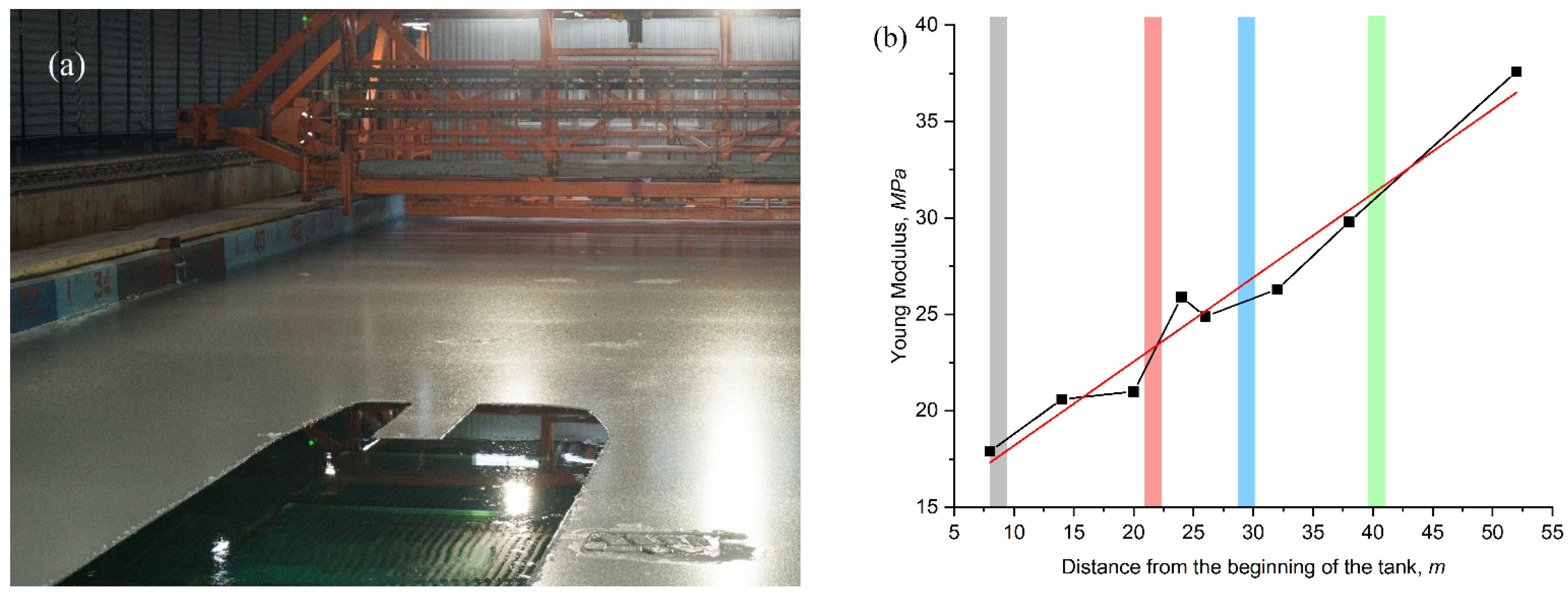

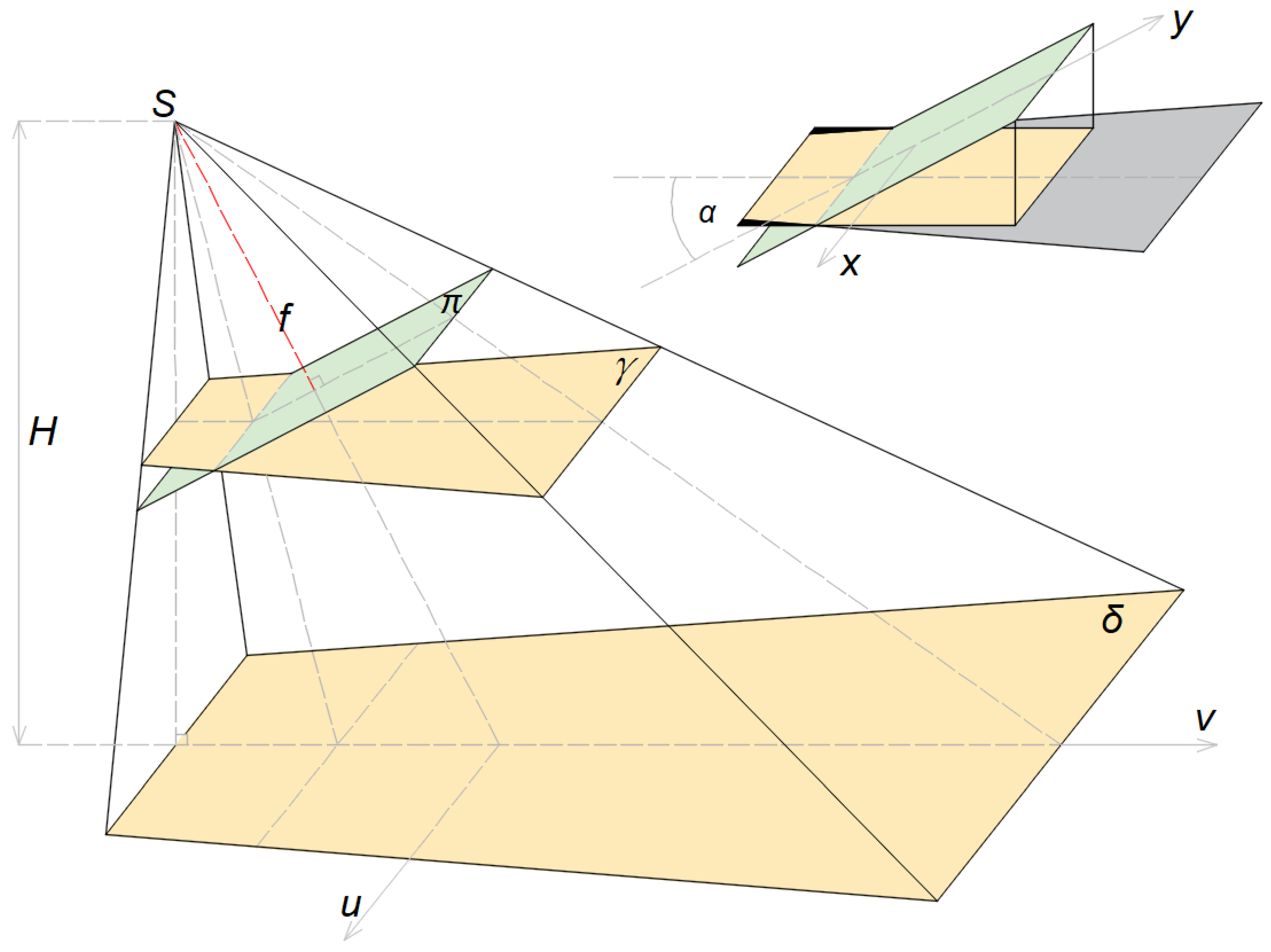

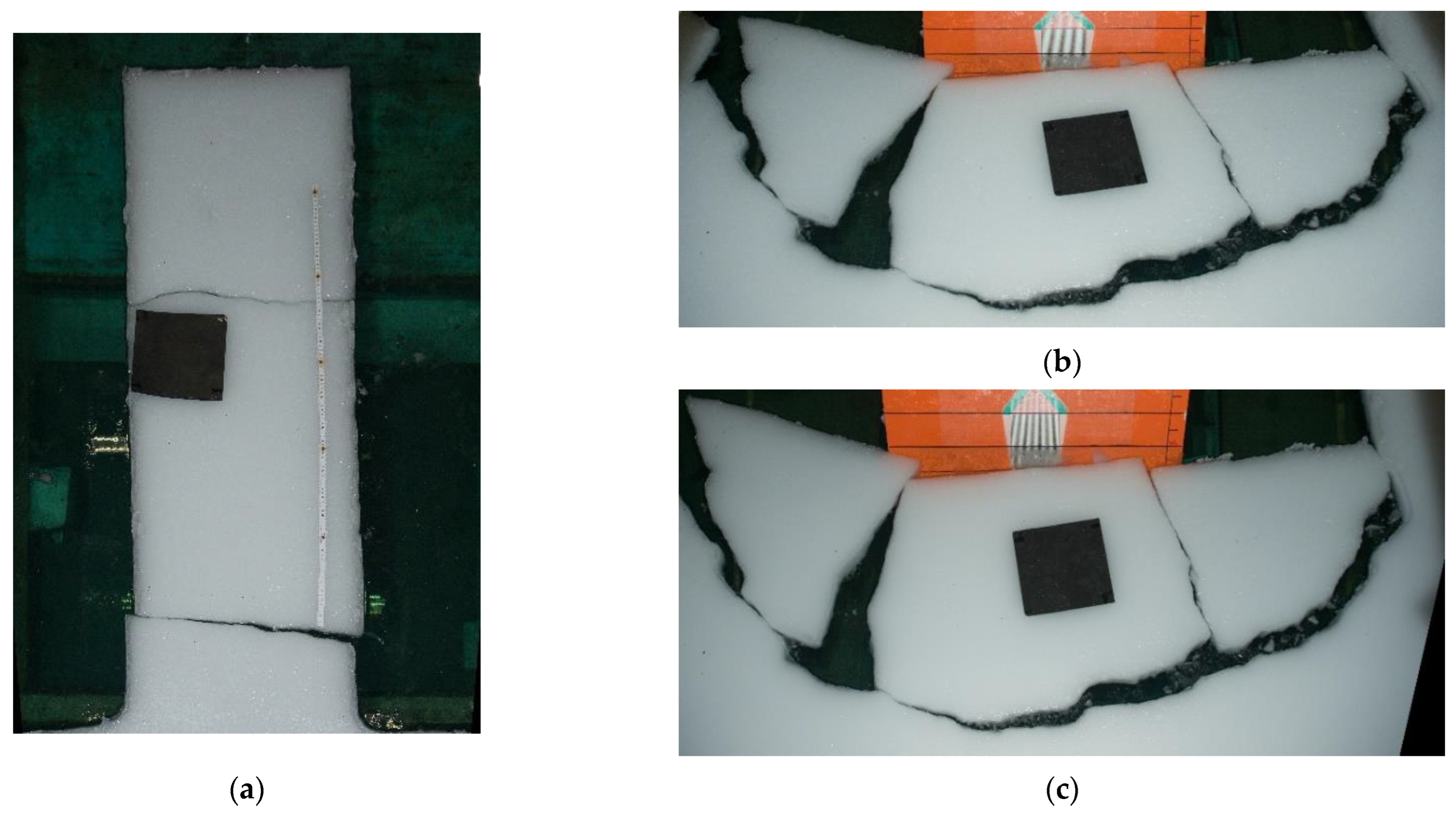

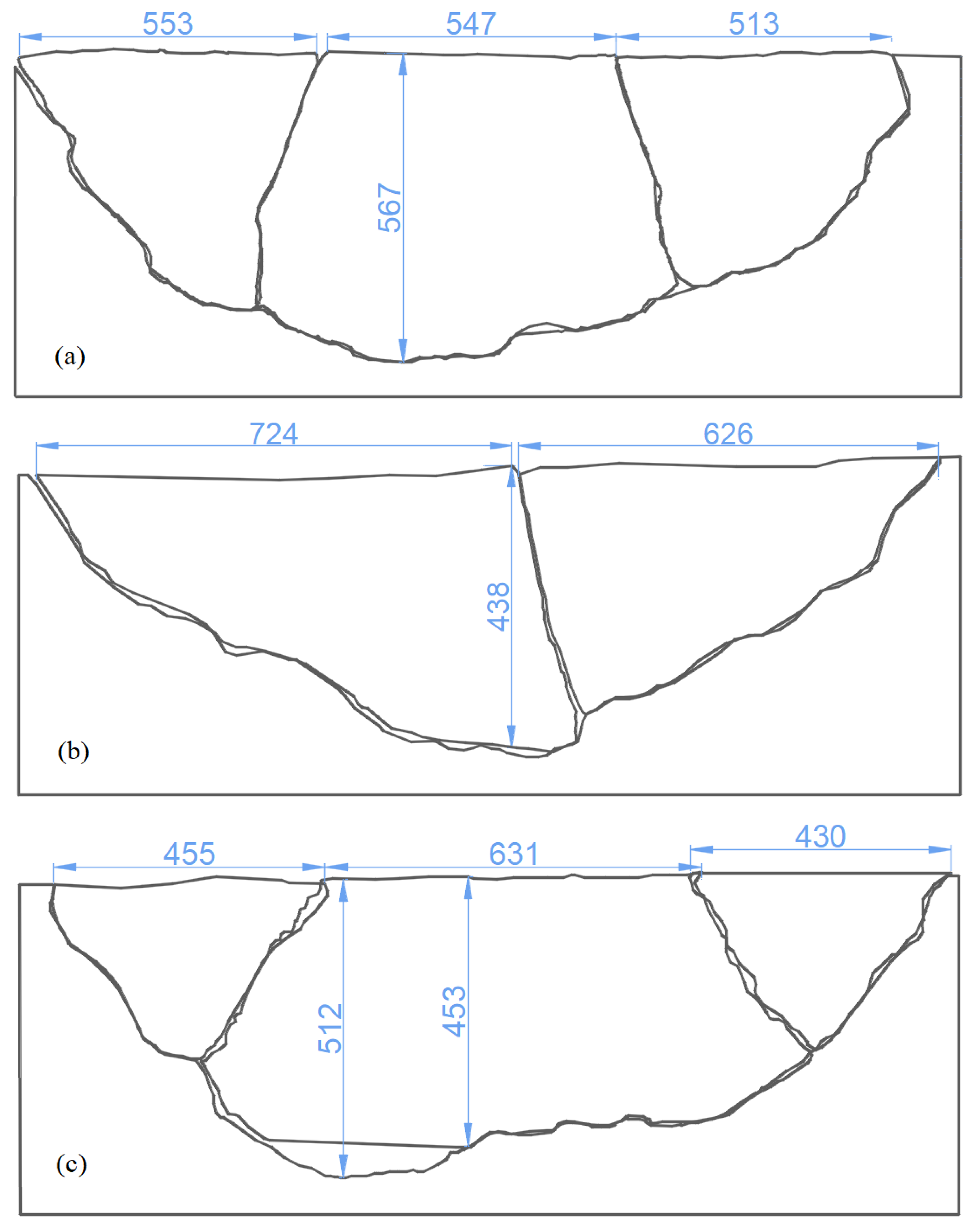
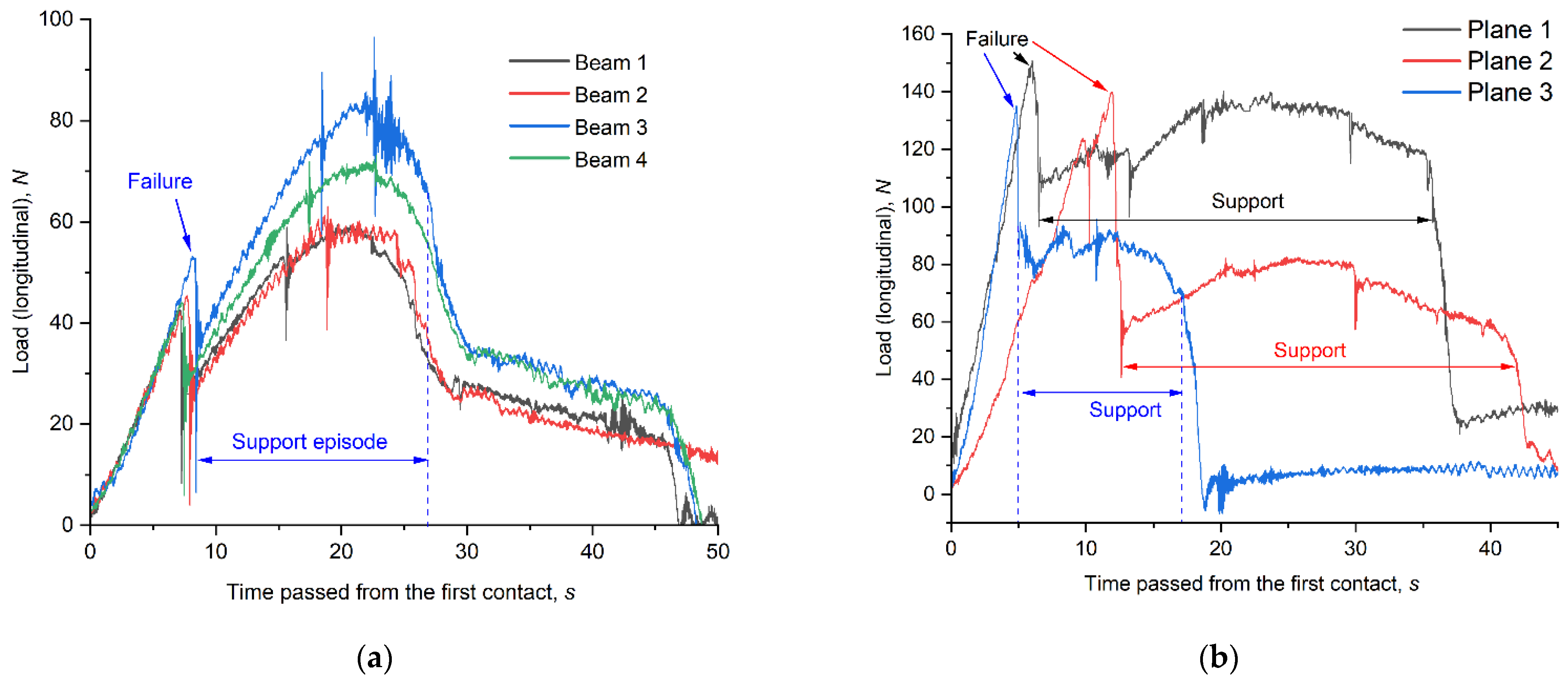

| Floe No | Date | Ice Floe Thickness, mm | Compressive Strength at Longwise Middle, kPa | Flexural Strength at Longwise Middle, kPa | ||
|---|---|---|---|---|---|---|
| Beginning of the Day | End of the Day | Beginning of the Day | End of the Day | |||
| 1 | 17 February 2021 | 49–50 | 26.0 | 33.1 | 23.6 | - |
| 2 | 18 August 2021 | 48–50 | 18.3 | 29.5 | 11.2 | 30.8 |
| After-Experiment Nadir Photo | Orthorectified Video Frame | Relative Discrepancy | ||||
|---|---|---|---|---|---|---|
| Fragment No | Linear Size, cm | Area, cm2 | Linear Size, cm | Area, cm2 | For Linear Size, % | For Area, % |
| 1 | 28.0 | 421.1 | 29.2 | 411.7 | −4.3 | 2.2 |
| 2 | 22.0 | 215.8 | 22.7 | 195.7 | −3.2 | 9.3 |
| 3 | 32.3 | 589.8 | 32.3 | 554.6 | 0.0 | 6.0 |
| 4 | 30.0 | 341.1 | 30.2 | 321.4 | −0.7 | 5.8 |
| 5 | 23.9 | 310.7 | 22.7 | 326.2 | 5.0 | −5.0 |
| 6 | 20.7 | 251.5 | 21.7 | 229.6 | −4.8 | 8.7 |
| 7 | 19.4 | 188.1 | 20.3 | 183.3 | −4.6 | 2.6 |
Publisher’s Note: MDPI stays neutral with regard to jurisdictional claims in published maps and institutional affiliations. |
© 2022 by the authors. Licensee MDPI, Basel, Switzerland. This article is an open access article distributed under the terms and conditions of the Creative Commons Attribution (CC BY) license (https://creativecommons.org/licenses/by/4.0/).
Share and Cite
Zvyagin, P.; Pavlov, I.; Zvyagina, T. Broken Ice Photogrammetry in Model-Scale Experiments with Sloped Structure. J. Mar. Sci. Eng. 2022, 10, 1590. https://doi.org/10.3390/jmse10111590
Zvyagin P, Pavlov I, Zvyagina T. Broken Ice Photogrammetry in Model-Scale Experiments with Sloped Structure. Journal of Marine Science and Engineering. 2022; 10(11):1590. https://doi.org/10.3390/jmse10111590
Chicago/Turabian StyleZvyagin, Petr, Ilia Pavlov, and Tatiana Zvyagina. 2022. "Broken Ice Photogrammetry in Model-Scale Experiments with Sloped Structure" Journal of Marine Science and Engineering 10, no. 11: 1590. https://doi.org/10.3390/jmse10111590






